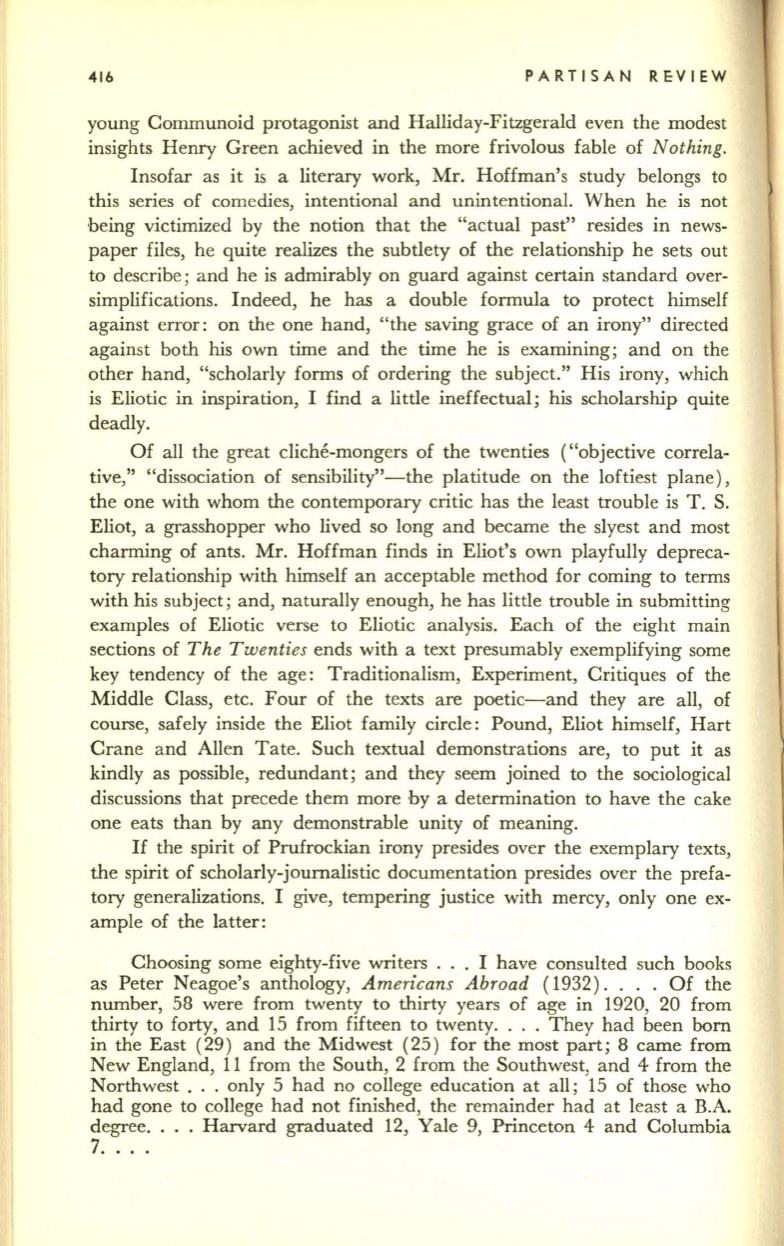
416
PARTISAN REVIEW
young Communoid protagonist and Halliday-Fitzgerald even the modest
insights Henry Green achieved in the more frivolous fable of
Nothing.
Insofar as it is a literary work, Mr. Hoffman's study belongs to
this series of comedies, intentional and unintentional. When he is not
being victimized by the notion that the "actual past" resides in news–
paper files, he quite realizes the subtlety of the relationship he sets out
to describe ; and he is admirably on guard against certain standard over–
simplifications. Indeed, he has a double formula to protect himself
against error: on the one hand, "the saving grace of an irony" directed
against both his own time and the time he is examining; and on the
other hand, "scholarly forms of ordering the subject." His irony, which
is Eliotic in inspiration, I find a little ineffectual; his scholarship quite
deadly.
Of all the great cliche-mongers of the twenties ("objective correla–
tive," "dissociation of sensibility"-the platitude on the loftiest plane),
the one with whom the contemporary critic has the least trouble is
T.
S.
Eliot, a grasshopper who lived so long and became the slyest and most
charming of ants. Mr. Hoffman finds in Eliot's own playfully depreca–
tory relationship with himself an acceptable method for coming to terms
with his subject; and, naturally enough, he has little trouble in submitting
examples of Eliotic verse to Eliotic analysis. Each of the eight main
sections of
The Twenties
ends with a text presumably exemplifying some
key tendency of the age: Traditionalism, Experiment, Critiques of the
Middle Class, etc. Four of the texts are poetic-and they are all, of
course, safely inside the Eliot family circle: Pound, Eliot himself, Hart
Crane and Allen Tate. Such textual demonstrations are, to put it as
kindly as possible, redundant; and they seem joined to the sociological
discussions that precede them more by a determination to have the cake
one eats than by any demonstrable unity of meaning.
If
the spirit of Prufrockian irony presides over the exemplary texts,
the spirit of scholarly-journalistic documentation presides over the prefa–
tory generalizations. I give, tempering justice with mercy, only one ex–
ample of the latter:
Choosing some eighty-five writers ... I have consulted such books
as Peter Neagoe's anthology,
Americans Abroad
(1932) .... Of the
number, 58 were from twenty to thirty years of age in 1920, 20 from
thirty to forty, and 15 from fifteen to twenty. ... They had been born
in the East (29) and the Midwest (25) for the most part; 8 came from
New England, 11 from the South, 2 from the Southwest, and 4 from the
Northwest .. . only 5 had no college education at all; 15 of those who
had gone to college had not finished, the remainder had at least a B.A.
degree.... Harvard graduated 12, Yale 9, Princeton 4 and Columbia
7.•..


